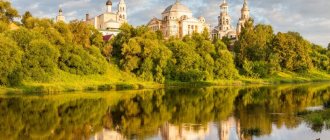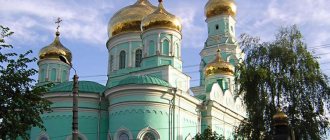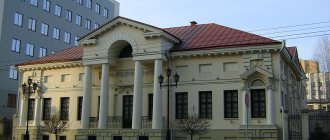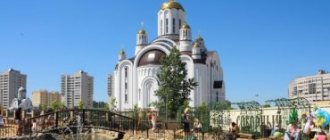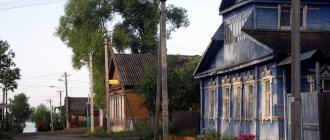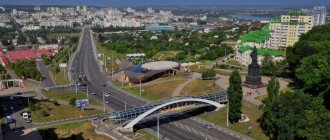Over its five-hundred-year history, Belgorod has changed many names, the most ancient being Belgorod Russian and Belaya Vezha. In ancient Russian chronicles, the settlement on the site of the modern city was called Sarkel.
The city on the white chalk mountain has preserved amazing architectural monuments and historical sites that you can visit while visiting this small but very hospitable city.
up
Museum "Battle of Kursk"
One of the bloodiest battles of the Great Patriotic War was the Battle of Kursk, which began with the breakthrough of Soviet troops in the Belgorod direction. The memory of the battle, where all types of weapons were involved: tanks, planes and artillery, is displayed in the Belgorod museum-diorama “Battle of Kursk”. This is a unique and large-scale reconstruction of a week-long battle, which can be viewed in the museum.
Among the exhibits you can see personal belongings of soldiers, documents, and a battle plan. Military equipment and weapons from the Second World War are collected in the open area. This is a popular place not only for tourists but also for locals, there is a beautiful park area around the museum where you can go.
up
Lesson - excursion “Around Belgorod with love”
Municipal budgetary institution of additional education
"Youth" of Belgorod
Lesson - excursion
“Around Belgorod with love”
to the section of the 4th year program “Museum thematic classes and excursions”, on the topic “Pedestrian excursion route “Monuments of Belgorod”
Stulikova Natalya Alekseevna
additional education teacher
MBUDO "Youth" Belgorod
Belgorod, 2016
Target:
to form a conscious attitude towards the Fatherland, its past, present and future based on the historical values of the native land.
Tasks:
- form the foundations of Belgorod studies,
- give knowledge about the history of the founding of the city,
- introduce the history of heraldic symbols of Belgorod,
- deepen knowledge about the city’s memorable places,
- to form in students a sense of pride in the heroic past of their small homeland,
- develop the ability to comprehend events and phenomena of reality in the interconnection of the past, present and future,
- develop logical thinking, memory, attention,
- developing interest and respect for the history and culture of the native land,
- develop a sense of patriotism,
- develop citizenship and self-awareness of students.
Lesson progress - excursions
Teacher:
Belgorod is rich in its historical and cultural heritage. There are many monuments in the city. What can the city’s memorable places tell us about?
Children
give answers: About people and events in the history of the city.
Teacher:
Today our lesson will take place in an unusual form; we will take a tour of an unusual museum - the “Open Air Museum”. What would you like to discover in this unusual museum? What is our goal when visiting the museum? What do we want to learn by studying the museum's exhibition? What tasks will we set to achieve our goal?
Children
give answers: We want to learn interesting facts from the history of the city - this will be our goal. To implement it, we must find objects on display in the museum, find out what they are dedicated to, determine the significance of the object in the history of the city, and how they influenced the formation of the city.
Teacher:
“Open Air Museum” is a creative project with the support of the city administration, which is designed to inform residents and guests of our city about the most important milestones in the history of Belgorod. Our excursion will begin on Narodny Boulevard. The entire territory of the boulevard is considered as a single exhibition space. Here, in various artistic forms, the main events of Belgorod’s past are reflected, primarily those associated with the founding of the city.
The Belgorod region has an ancient history. At the end of 1593, Tsar Fyodor Ioannovich ordered, in order to protect against the constant raids of the Crimean Tatars, to build new fortified cities on all Tatar routes from the Donets to the banks of the Oka and to populate them with people of military archers and Cossacks. This is how Belgorod, Oskol, Valuiki and other cities arose.
On Narodny Boulevard, opposite the building of the Belgorod State Philharmonic Society, a sculpture of Tsar Fyodor Ioannovich
. The author of the monument is Honored Artist of Russia, sculptor from the city of Zlatoust, Chelyabinsk region, Alexander Lokhtachev.
Questions for children:
- How would you characterize Tsar Fyodor Ioannovich, looking at his sculpture? What was his character like?
- By what signs can one determine that the image of the person depicted on the throne is a king?
- What does the inscription on the monument indicate?
After listening to the children’s answers, the teacher continues:
The Belgorod fortress was built by the autumn of 1596. Its builders were the governors, princes Mikhail Nozdrevaty and Andrei Volkonsky. The first fortress did not last long; in 1612 it was plundered and burned by Polish-Lithuanian invaders. They did not restore it in its original place, but moved it to a new one - the left bank of the Seversky Donets. In connection with the construction of defensive structures of the Belgorod area in 1646, a decision was made to move the fortress to the Karpovsky Val on the right bank of the Seversky Donets near the Vezenitsa River (Veselitsa or Vezelka) - this is the area of the central part of present-day Belgorod.
From the very beginning of its foundation until the middle of the 18th century, the Belgorod fortress was considered an important fortress, and military service in this city until the time of Peter the Great was considered very difficult. Almost continuous chains of fortifications stretched from Belgorod to the Oka and Don. As a result, the Belgorod Line arose, stretching for more than 800 km (across the territory of the modern Belgorod region - 425 km, 10 fortresses: Khotmyzhsk, Karpov, Bolkhovets, Belgorod, Nezhegolsk, Korocha, Yablonov, Tsarev-Alekseev, Verkhososensk, Userd)
Questions for children:
- Which of the listed cities are familiar to you, or are in tune with modern settlements in the Belgorod region?
After listening to the children’s answers, the teacher explains:
- Belgorod, Khotmyzhsk, Bolkhovets, Korocha - the names remain the same, but only Belgorod is a city.
- With. Nezhegol, Alekseevka, village. Verkhososna, village Yablonovo - are consonant with today's names of villages and cities.
- Userd - previously existed as a fortified city at the confluence of the Tikhaya Sosna and Userd rivers in the Belgorod region, now the village of Streletskoye. The city-fortress of Karpov today is the village. Pushkarnoye, Dragunskoye, Kozatskoye.
The excursion group moves further along the People's Boulevard. As the movement progresses, the teacher tells the story:
In 1708-1727 The territory of the modern Belgorod region was part of the Kyiv and Azov provinces. In 1727, by decree of the Senate (the reign of Catherine I), the Belgorod province was formed. It occupied the lands not only of modern Belgorod, but also the territories of modern Kursk, Oryol, partially Bryansk and Kharkov regions. The city of Belgorod became the provincial center. The province included more than 35 cities.
Approaching the next excursion object, the teacher asks the children a question:
- Who do you think the monument is dedicated to?
After listening to the answer options, he explains:
Over the 52 years of its existence, the Belgorod province had more than 10 governors. But the first Belgorod governor was a representative of an old family - Prince Yuri Yuryevich Trubetskoy
, who ruled the province for three years, future Privy Councilor and Senator. The author of the bronze monument, sculptor Olga Trofimenko (with the participation of architect Maxim Khromov and Honored Artist of Russia, sculptor Anatoly Shishkov) depicted the prince in a static state pose: Trubetskoy’s left hand lies on the hilt of the sword, in his right he holds a scroll depicting the coat of arms of Belgorod.
The excursion group continues along the People's Boulevard and approaches the next excursion site.
A memorial sign in honor of the 300th anniversary
of the Battle
is a famous monument at the intersection of Belgorod Regiment Street and Narodny Boulevard. On a huge stone pedestal there is a bronze medallion, which was made by sculptor Taras Kostenko. The memorial sign was installed in memory of the participation of the Belgorod Infantry Regiment in the Battle of Poltava and the presentation of the banner to the Belgorod Infantry Regiment by Peter I.
2 years after the founding of Belgorod, in 1658, the Belgorod Regiment was formed - a large permanent military formation, which included all the armed forces on the Belgorod border and was subordinate to the Belgorod governor. The prince, boyar Grigory Grigorievich Romodanovsky was appointed chief governor of the Belgorod regiment. The voivode was the full-fledged owner and chief commander of the guard and village service. In wartime, he organized the defense of the city from the enemy and became the head of the army. The Belgorod regiment became famous in many battles with the Tatars, in the war with Poland, in the Azov campaigns of Peter I. Many times the regiment received words of gratitude from Tsars Alexei Mikhailovich and Peter I, and its soldiers received personal awards in gold, land, and cash awards.
According to local historian Alexander Krupenkov, in the Battle of Poltava (June 27 (July 10), 1709), which became a turning point in the Northern War, the soldiers of the Belgorod Infantry Regiment made a great contribution to the victory of the Russian army. For this, many of them were given awards, and from Peter I the entire regiment received a banner with a reclining lion and a soaring eagle (the army was just introducing banners for regiments with territorial emblems).
The medallion is engraved with the regimental banner, which depicts a soaring eagle and a reclining lion. They symbolize courage, strength, greatness, insight and power of Belgorod warriors. There is also a portrait of the leader of the battle, Emperor Peter I, and images of several soldiers.
Question for children:
- What is the connection between the memorial sign about the participation of the Belgorod Infantry Regiment in the Battle of Poltava and the presentation of the banner to the Belgorod Infantry Regiment by Peter I and the monument to the first governor?
To answer this question correctly, it is necessary to build a logical chain. Children are given cards with words that they must arrange in the following sequence: fortress - Belgorod regiment - flag - as a symbol of the Belgorod regiment - formation of the province - first governor - symbol of the province, flag and coat of arms.
Based on the logical chain, children should draw the following conclusion: the banner of the Belgorod regiment served as the basis for the heraldry of the Belgorod province, which was approved by the first governor Yu. Yu. Trubitsky. That is why this coat of arms is depicted on the scroll held by the first governor.
The teacher shows the flag and coat of arms of the Belgorod regiment, and the modern coat of arms of the Belgorod region and asks to find similarities and differences.
The teacher sums it up: in 1730, under Governor Yu.Yu. Trubetskoy approved the first provincial coat of arms of the city of Belgorod, which was recreated several years ago and is now the coat of arms of the Belgorod region.
Moving along Narodny Boulevard, we approach “Lyceum No. 9”
.
And opposite is the sculptural composition “My First Teacher”
.
Question for children:
- Why do you think this sculptural composition was installed here?
Children make a guess.
The teacher gives the task:
- Enter the Lyceum territory and look on the building for a clue to answer the question.
(There are two memorial plaques on the lyceum building. One of them indicates that the lyceum building is an architectural monument of the 19th century and is protected by the state. Based on this information, children can conclude that this lyceum is the oldest school in the city.)
Children give an answer, the teacher explains and clarifies:
The history of the creation of the municipal educational institution “Lyceum No. 9” dates back to 1860, when, at the request of the local nobility and the leader, His Serene Highness Prince Saltykov-Golovkin, the “Belgorod Women’s School of the 2nd category” was opened, consisting of three classes. In 1880, the first graduation of female gymnasium students took place. 1939-1941 there was a 2-year teachers' institute here. In the fall of 1941, during the retreat of Soviet troops, military hospital No. 1923 was located in the gymnasium building, as evidenced by the second memorial plaque. From October 24, 1941 until August 5, 1943, during the occupation, the gymnasium building housed German warehouses and a stable.
In 1957, secondary school No. 9 began operating in a building restored and renovated after war destruction.
In 2004, the gymnasium was transformed into a municipal educational institution “Lyceum No. 9”.
And it is not surprising that next to the lyceum, which has such a history, there is a contact sculpture composition “My First Teacher...”. The idea of creating the monument belonged to Belgorod teachers and schoolchildren, and it was brought to life by local Tsereteli - sculptor Taras Kostenko, he is the author of many monuments in Belgorod. The author of the sculpture worked on the project for six months, consulting with teachers on how best to immortalize school moments in bronze. According to the sculptor, everyone has their own first teacher, so the image turned out to be collective.
From the history of the birth of the Belgorod fortress and the Belgorod province, we will move on to the history of the Great Patriotic War. Near “Lyceum No. 9”, at the intersection of Narodny Boulevard and st. A. Popov, there is a memorial pedestal with a bust of tanker Andrei Popov
is not only a memory of the hero, but also a symbol of the liberation of Belgorod.
In 1943, Andrei Popov's tank was the first to enter the streets of the city occupied by the Nazis and was almost immediately hit by enemies. Knowing full well what fate awaited him after entering the territory of occupation, Andrei Popov, with his feat, opened the way to besieged Belgorod for an entire battalion of the Red Army. The brave tanker managed to escape the burning car, but on the same day Andrei Popov died in street fighting. Senior Lieutenant Popov was only 22 years old.
The hero’s burial place was the now widely known mass grave on Cathedral Square. There, in honor of the heroes who died for their homeland, an eternal flame was lit.
The monument to Guard Senior Lieutenant A.I. Popov was erected on June 8, 1957. The street on which the monument stands is also named after the tank hero. The creation of the monument was carried out by the capital's sculptor A. I. Teneta and the Belgorod architect Ya. P. Mukhin.
Andrei Ivanovich Popov (1921-1943) – senior lieutenant, commander of a tank platoon, which played an important role in the battle for the liberation of Belgorod from the German occupiers in February 1943.
Question for children:
- Name the streets of our city that were named in honor of the heroes of the Great Patriotic War?
Children give answers: Mikhail Lebed Street, Ivan Konev Street, Joseph Apanasenko Street, Nikolai Vatutin Avenue, Valdemar Shalandin Street, Nikolai Shershnev Street, etc...
The group moves further down the street. Popov until the intersection with Grazhdansky Avenue, where Cathedral Square
— the main square of Belgorod.
The teacher tells the story of the creation of the square:
From the plan of the “Kursk governorship of the district Bela Gorod”, approved on April 26, 1768 by Empress Catherine II, it is known that in the 18th century the square was called Bolshoi due to its characteristic feature; at that time it was even larger in size than it is today.
The name of the square has changed several times during its history. Cathedral (1800-1920), Victims of counter-revolution (1920-1927), Revolution (from 1927 -2004). In 2004 it was renamed Sobornaya. Before the Revolution, on the territory of the square there was the Nativity of the Virgin Mary convent, which was destroyed after the revolution. It was he who gave the square the name Sobornaya.
On Cathedral Square there is the building of the Administration of the Belgorod Region, the Belgorod Hotel, a memorial sign on the site of the former Nativity of the Virgin Mary Monastery, as well as a chapel in honor of St. Prince Vladimir.
The teacher gives the task:
- Walk around the square and find three more objects related to the history of our city, and three objects related to the culture of the Belgorod region. Which of the objects best reflects the information received during the lesson - excursion?
Children must find objects related to history: the monument-stele “City of Military Glory”, where four steles contain artistic reliefs on which the main milestones of the city’s military history are depicted using visual means. It is they that reflect most of the information of the lesson - excursions, the memorial complex “Eternal Flame” consisting of a stela of the figure of a warrior and a worker bowing their banners as a sign of grief for their fallen comrades, as well as the sculptural composition “Grieving Mother with Child”, and objects associated with culture of the Belgorod region: Belgorod State Academic Drama Theater named after M. S. Shchepkin, a monument to M. S. Shchepkin, the composition “Belgorod Region”, which is a unique paved pattern made in the traditions of southern Russian ornamental embroidery (this object may cause difficulty , since it is quite large and is under your feet).
Having learned about the results of the task, the teacher provides information about the objects found:
Our city has always been one of the most important lines of defense, but if from the times of the old fortresses the mass graves of the city’s defenders were not preserved, and there were no memorial traditions; The 20th century left a large number of monuments to fallen soldiers. The most “important” memorial complex is located in the city center on Cathedral Square. Just two decades ago, “post No. 1” was located here, where conscripts and young patriots kept watch.
Memorial complex - mass grave
, who died in 1918-1919 and 1941-1943. opened on August 5, 1959. The authors of the architectural and sculptural composition are sculptor, Honored Artist G.V. Neroda and architect I.A. Frenchman. A sculptural composition of a grieving mother and child rises above the mass grave. In the child’s hands is a wreath with the inscription “Glory to the Heroes!” At the foot of the monument the Eternal Flame burns. The memorial complex is opened by two tall steles carved from limestone. On them are figures of a warrior and a worker, bowing their banners as a sign of grief for their fallen comrades. On the other side, on the steles there are memorial plates with the names of one hundred and sixty-seven famous soldiers who died in the battles for Belgorod.
On the memorial plaques at the foot of the monument there are many names that are well known to Belgorod residents: Army General I.R. Apanasenko, Major General M.P. Lebed, senior lieutenant A.I. Popov and others. Among those resting in the mass grave are two girls who gave their lives in the battles for Belgorod: a Red Army soldier of the communications battalion, Varya Kolomeytseva, who died on March 10, 1943, and a Red Army soldier from a Muscovite rifle regiment, Zina Neugasova, who was killed by the Nazis on March 15, 1943.
Stella "City of Military Glory"
another memorable place in Belgorod. City of Military Glory is an honorary title of the Russian Federation, awarded to individual cities “for the courage, fortitude and mass heroism shown by the city’s defenders in the struggle for the freedom and independence of the Fatherland.” By Decree of the President of the Russian Federation dated April 27, 2007 No. 558, Belgorod, the first of the cities, was awarded an honorary title. The following decrees immortalized the exploits of Kursk and Orel. The winner of the competition for the best solution to the memorable composition was the project of the team led by the main artist of Moscow Igor Voskresensky.
The monument is a single integral composition of several architectural elements. On a thematically and stylistically designed site there is a symmetrical square stylobate, on the surface of which all the details of the monument are placed. The central object is a stone obelisk, around which massive stone blocks - steles - are installed at the corners of the stylobate. On four steles there are artistic reliefs on which the main milestones of the city’s military history are depicted using visual means. The peculiarity of the review of the ensemble is that it is simultaneously designed for perception both from distant points and for direct reading of its elements close up (reliefs, texts).
On Cathedral Square there are: BGADT named after M. S. Shchepkin and a monument to M. S. Shchepkin.
The first mentions of the theater, preserved in the archives, date back to October 1936 - it was then that the Belgorod Collective and State Farm Theater began its work.
The Great Patriotic War found the theater on tour. In 1944, after the liberation of the regional center, the troupe, which did not stop giving performances and concerts during the evacuation, returned to Belgorod and began work again.
The year 1954 became a turning point in the history of our region and the theater. This year, when the Belgorod region was formed, and the theater received the status of a regional theater. Two years later, it was named after our fellow countryman, the great Russian actor Mikhail Semyonovich Shchepkin. In 1962, the theater moved to a new, specially built building in the city center. In 1998, the theater was given the honorary name “academic”.
The Shchepkinites toured in many cities of Russia, Ukraine, the Baltic states, Poland, and Serbia. Belgorod drama takes part in Russian and international theater festivals. At the X Theater Forum, “Golden Knight” won the highest award - the “Golden Knight” statuette and a diploma for the best large-scale performance, and was awarded a silver medal at the 1st International Delphic Games. According to the results of the All-Russian competition “Window to Russia”, he became a laureate in the category “Theater of the Year - 99”; in 2006 he was awarded the First Prize of the Central Federal District - “For achievements in the field of theatrical art.”
A special place in the history of the theater is the All-Russian festival “Actors of Russia - Mikhail Shchepkin” - the first acting festival in the country. The Belgorod Theater became its organizer and driving force. Born in 1988, in the year of the 200th anniversary of the great artist, over the past years he has gathered about a hundred theaters in Russia, Belarus, Ukraine, Serbia into his circle and took a worthy place in the theatrical life of the country.
The roots of Belgorod theatrical art go back to the village of Alekseevka, Belgorod region, the homeland of the great actor of the 18th century M.S. Shchepkin. He was the son of a courtyard man, Count Volkenstein, who managed all the landowner’s estates. Little Misha was 7 years old when he first saw a performance in his master's home theater. This sight amazed him. The landowner, seeing the abilities of the smart boy, sent him to study at the Kursk School. Misha studied well, read a lot, and acted in school plays. His interest in theater did not wane, but turned into a desire to become an actor. Once he gave a welcoming speech at the opening of a gymnasium and showed so much feeling and talent that the landowner allowed him to enter the theater.
He was a versatile actor and could play not only dramatic roles, but also comedic ones, sing in opera and dance. The main merit of Shchepkin M.S. it was that he was one of the founders of stage realism. The first actor who began to speak and behave on stage as truthfully and naturally as in life. He followed a real, not an imagined life.
Remaining a serf, the talented actor wandered from city to city in different theaters for more than 20 years. The actor amazed everyone with his performance. The actor, known throughout Russia, only at the age of 35 became a “free” person, with the help of friends he raised money for the ransom of M.S. Shchepkin. and his family from serfdom. Mikhail Semenovich Shchepkin until his death (1863) remained the leading artist of the troupe of the Maly Theater in the capital of Russia.
The actors of the Belgorod Academic Drama Theater perceive the name of Mikhail Semyonovich Shchepkin not as a prefix to the title of the theater, but as a high blessing of Fate.
The square is decorated with the composition “Belgorod Region”, created by sculptor B.M. Pupynin, architect V.V. Pertsev, which was opened in 2000, and is part of the decorative design of the pavement. The composition is a unique paved pattern: in the center there is a large copper circle depicting a map of the Belgorod region, and along the perimeter of the circle there are 21 metal rectangles with the coats of arms of districts and urban districts of the Belgorod region. The elements are highlighted with a pattern using tiles in red and beige shades against a general background of gray. When viewed from above, the design reads like traditional South Russian ornamentation of embroidery and painting, based on cosmogonic symbols: solar signs, signs of earth, fertility.
Reflection.
Our lesson - excursion has come to an end. Let's summarize:
- Was the lesson useful to you?
- Did you like the format of the lesson? How?
- What were you familiar with during the lesson - excursions?
- What information did you find most interesting?
- What information can be useful to you in class and in life?
- What information will you share with family and friends?
- What surprised you during the lesson - excursion?
- How did you feel at the end of the lesson?
- What didn't you like?
- What else would you like to know about the objects of our city?
Literature and Internet sources
1. Encyclopedia of the Belgorod region https://belogorie.info/krugloe_zdanie_v_sele_golovchino
2. Monuments and sculptures of Belgorod https://yakaev.livejournal.com/44021.html
3. Steps around Belgorod.
https://sanchess-city31.livejournal.com/46358.html
4. Eternal Flame Memorial
https://inbelgorod.ru/places/dostoprimechatelnosti/memorial-vechnyiy-ogon.html
5. Sights of Belgorod
https://www.go-on-travels.ru/article.php?narticle=158
6. Andrey Sergeevich Laptev. History of Geographical Names of Rus'
Kichigin V.P., Baranov M.B., Set of postcards “Greetings from Belgorod” - Belgorod: Fatherland, 1994
7. Memorial sign in honor of the 300th anniversary of the Battle of Poltava https://www.rutraveller.ru/place/65676
8. History of the city - in memorial plaques https://belgorod.bezformata.ru/listnews/istoriya-goroda-v-memorialnih-doskah/27465146/
9. Special project: Street of Heroes https://belgorodtv.ru/?page_id=72258
10. Steps around Belgorod. https://sanchess-city31.livejournal.com/46358.html
Historical Museum
The history of the Belgorod History Museum began in 1924. Interesting archaeological and cultural exhibits telling about the history of the region were collected here. During the war, the collection was destroyed. The restoration of the museum's funds began in 1946, but it was only in the early 90s that the museum opened to visitors.
Here you can look at historical documents, art objects and history of the city. In a separate room there is an exhibition dedicated to the flora and fauna of the region. The collection of household items from the 18th and 19th centuries is interesting; the main attraction of the exhibition is considered to be several ancient artifacts donated to the museum by archaeological expeditions.
up
Relevant products in the Online store:
Kilian
Woman in Gold Travel Set
RUB 16,405 19,300 rub.
Percy&Reed
TURN UP THE VOLUME Dry volume shampoo Create volume, travel bottle
536 rub. 670 rub.
exclusive
Kilian
Moonlight In Heaven Travel Set
RUB 16,405 19,300 rub.
Kilian
Good Girl Gone Bad Travel Set
RUB 16,405 19,300 rub.
All goods
Art Museum
Where you should definitely go in Belgorod is the Art Museum, where a unique exhibition of Russian painting of the 20th century is presented, numbering more than 2,000 canvases.
In total, the museum stores more than 4,000 exhibits, including paintings, sculptures and graphic drawings. In 2007, the museum moved to a new building, which is considered one of the most beautiful in the city.
up
Victory Park
Where you should definitely go in the city is Victory Park, which is located on the banks of the Vezelka River and is located in the center of Belgorod. This is one of the most beautiful places to visit. Among the lush vegetation there are comfortable sidewalks along which you can wander for hours. Fountains, cozy cafes, and comfortable benches are installed throughout the park.
On the river bank you can rent a boat and take an excursion either to the opposite bank or along the riverbed. In the center of the park there is a Victory Monument and the Walk of Glory, where ceremonial events can often be observed.
up
Amusement park "GrinnLandia"
The most famous amusement park not only in Belgorod, but also in the region, is “GrinnLandia”, an exciting and fun place that you should definitely visit if you come to the city with children. On a large territory there are modern carousels, slides, funhouses and dozens of other fun attractions that will bring unique pleasure to little visitors.
Among the cheerful carousels there are cozy cafes where you can eat tasty and inexpensive food and relax. Fans of gambling are invited to play board games with generous prizes.
up
Belgorod State Philharmonic
Belgorod State Philharmonic
Belgorod
The Belgorod Philharmonic is already more than half a century old: it appeared in 1966, when the city concert and variety bureau was transformed. Pop groups appeared in Belgorod; Mstislav Rostropovich, Svyatoslav Richter, Boris Shtokolov and other famous musicians came here to give concerts. In the 1990s, a symphony orchestra was founded.
Today the Philharmonic includes many creative groups: a symphony orchestra, an orchestra of Russian folk instruments, a chamber choir, a big band No comment, the song and dance ensemble “Belogorye” and many others. In 2011, the Organ Hall opened here. Every year the Philharmonic hosts traditional music festivals - “Sheremetev Musical Assemblies”, the Festival of Contemporary Music and Christmas Choral Assemblies, the Moscow Easter Festival of Valery Gergiev.
Literary Museum
While touring the region, all connoisseurs of the written word are recommended to visit the only Belgorod Museum of Literature in the region. Here, connoisseurs of beautifully expressed thoughts will encounter an extraordinary miracle - the creativity of writers.
The exhibition presents drafts, diaries, correspondence of many famous writers, both modern and past centuries. The exhibits are displayed in five halls; in addition to the permanent exhibition, the museum often hosts thematic excursions and meetings with contemporary writers.
up
Tips and reviews from tourists
Belgorod is visited for various reasons, and one of them is tourism. People come to get to know the city for one day, including it in a big tour along the western borders of Russia, or set aside several days for a detailed study. Belgorod can be liked or controversial, surprising or not meeting expectations - this is how you can describe the impressions of tourists who visit it.
The first images of Belgorod will help compile user reviews:
- miljkovic14 in the story “Belgorod. May 2019";
- Alexandra Goretova in the publication “Belgorod - a city of living museums and fascinating parks”;
- Studio Spbtales in “Purely in Belgorod (travel to Belgorod)”;
- as well as the photo album “Belogorye” from Evgeny Sapronov.
All tourist reviews about Belgorod on Tourist. RU
Hotel "Belgorod" Photo: © miljkovic14
May be useful:
- background information from the guidebook;
- tips on how to get to Belgorod from different cities of Russia;
- advice on what to bring from Belgorod.
Lenin Park
What is the first thing you can see in the city? A masterpiece of landscape architecture, which is most fully displayed in the city’s central park. IN AND. Lenin.
The green zone occupies more than half of the park; the traditional Soviet design style has been preserved here and modern technical structures have been added. Multi-level fountains, playgrounds with safe carousels and slides will bring many memorable hours to every vacationer. For the little ones, there is a play area in the park where you can have fun playing and enjoy dessert and ice cream.
up
Smolensky Cathedral
One of the main attractions of the city, which has great historical and religious value, is the Smolensk Cathedral, built in the center of Belgorod. Construction of the cathedral began after a miraculous vision of the Mother of God. In a small chapel, sunlight began to emit from the Image of the Virgin Mary, from which candles were lit. In memory of the miracle, a cathedral was built on the site of the chapel.
The monumental and majestic building was destroyed several times; during the Soviet period, the Cathedral was blown up twice and attempts were made to destroy it several times. In 1994, a large-scale reconstruction of the Orthodox shrine and its restoration began. Today it is a functioning temple, where you can go both on an excursion and to worship.
up
Monument to the local patron saint of Belogorye, Saint Joasaph Bishop of Belgorod
Holy Trinity Boulevard stretches like a spiritual thread through the city center. Part of the former Lenin Avenue received this name in 2004. It is natural that the boulevard is crowned with a monument to the local patron of the holy Belogorye, Saint Joasaph, Bishop of Belgorod. The work was performed by sculptor A.A. Shishkov. Initially, the monument was located in front of the theological seminary building on Belgorodsky Prospekt, and when a park was landscaped in front of the Intercession Church, but on June 2, 2004, the moved monument was inaugurated in a new location. Throughout 2005, a lot of events were organized and held in Belgorod to mark the 300th anniversary of the birth of Joasaph. Nowadays people make appointments at the monument, walk here, think about their future and the future of the Belgorod region, spiritually consulting with the Patron. Marfo-Mariinsky Convent (Pushkin St., 19) 50°35.794′ N. w. 36°34.592′E e. Expression error: unrecognized punctuation character "," , Expression error: unrecognized punctuation character "," &spn=0.3,0.3&t=k&hl=ru (G)
Very close to the monument to St. Joasaphoon there is a complex of buildings of the Martha and Mary Convent. Its construction began in 1993, in connection with the restoration of the Intercession Church. On its territory is the Assumption-Nicholas Cathedral, which is an original example of provincial architecture with an asymmetrical plan, rare for our region.
The temple is located on the territory of the former Zhilaya settlement, which was inhabited by military men of the Belgorod garrison, along the current Pushkin Street (formerly Battalionnaya). In the second half of the 18th century, the Intercession Church was built north of the Assumption Cathedral. Today these buildings form a single temple complex.
There is still a legend about how Peter I donated one hundred rubles for the construction of the cathedral. There is documentary evidence of this. The cathedral was built of brick, plastered inside and out. Construction was carried out by soldiers of the Belgorod garrison, archers and a team of craftsmen from Moscow led by Ivan Prokofiev. They introduced Moscow features into the architecture of the temple.
In the early 30s of the 20th century, the cathedral was closed. It began to be used for economic needs. In the process of barbaric exploitation, the ringing tier of the bell tower and the completion of the quadrangle of the temple were destroyed. Interior decorations were looted or destroyed. In 1998, the cathedral was transferred to the Belgorod-Starooskol diocese.
To date, the temple has been restored, the chapel, utility buildings and workshops have been built and restored. By 1999, the monastery already had 35 nuns. The monastery operates a charity canteen, a Sunday school for children, a school for adults according to the Law of God, and an icon-painting class.
Zoo
In the Sosnovka tract on the outskirts of the city there is one of the most popular places for summer walks. This is the Belgorod Zoo, which opened several years ago. The park area is divided into 43 thematic sections, where several hundred species of animals are located.
The zoo's inhabitants were given living conditions as close to natural as possible. The zoo is home to more than a hundred species of birds, some of which stay here for the winter. This is an interesting place in the city where you can go with your family. For children, the park has an amusement area, slides and a large entertainment circus complex.
up

